fuel CHRYSLER CROSSFIRE 2007 1.G Owner's Guide
[x] Cancel search | Manufacturer: CHRYSLER, Model Year: 2007, Model line: CROSSFIRE, Model: CHRYSLER CROSSFIRE 2007 1.GPages: 299, PDF Size: 8.26 MB
Page 241 of 299

Points to Remember
NOTE:
When the vehicle is stopped after a few miles/
kilometers of operation, you may observe vapor coming
from the front of the engine compartment. This is nor-
mally a result of moisture from rain, snow, or high
humidity accumulation on the radiator and being vapor-
ized when the thermostat opens, allowing hot water to
enter the radiator.
If an examination of your engine compartment shows no
evidence of radiator or hose leaks, the vehicle may be
safely driven. The vapor will soon dissipate.
²Do not overfill the coolant bottle.
²Check coolant freeze point in the system.
²If frequent coolant additions are required, or if the
level in the recovery bottle does not drop when the
engine cools, the cooling system should be pressure
tested for leaks.
²Maintain a coolant concentration of a minimum of 50%
ethylene glycol Extended Life Coolant and high qual-
ity water with recommended antifreeze for proper
corrosion protection of your engine cooling system
that contains aluminum components.
²Make sure that the radiator and coolant bottle hoses
are not kinked or obstructed.
²Keep the front of the radiator clean. If your vehicle has
air conditioning, keep the front of the condenser clean,
also.
²Do not change the thermostat for summer or winter
operation. If replacement is ever necessary, install
ONLY the correct type thermostat. Other designs may
result in unsatisfactory coolant performance, poor fuel
economy, and increased emissions.
Hoses And Vacuum/Vapor Harnesses
Inspect surfaces of hoses and nylon tubing for evidence
of heat and mechanical damage. Hard or soft spots,
brittle rubber, cracking, checking, tears, cuts, abrasions,
and excessive swelling indicate deterioration of the rub-
ber.
Pay particular attention to the hoses nearest to high heat
sources such as the exhaust manifold. Inspect hose rout-
ing to be sure hoses do not touch any heat source or
moving component that may cause heat damage or
mechanical wear.
MAINTAINING YOUR VEHICLE 241
7
Page 258 of 299
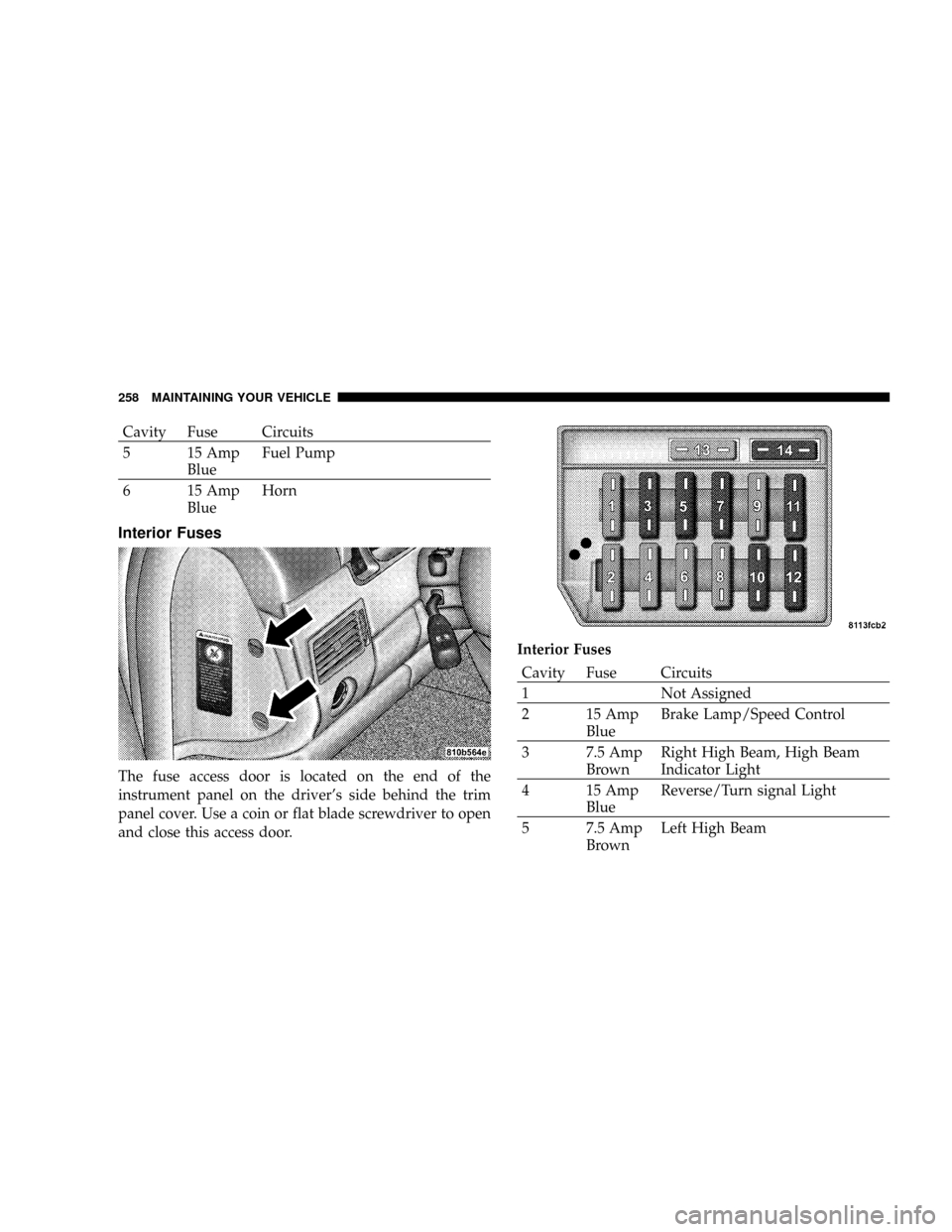
Cavity Fuse Circuits
5 15 Amp
BlueFuel Pump
6 15 Amp
BlueHorn
Interior Fuses
The fuse access door is located on the end of the
instrument panel on the driver's side behind the trim
panel cover. Use a coin or flat blade screwdriver to open
and close this access door.Interior Fuses
Cavity Fuse Circuits
1 Not Assigned
2 15 Amp
BlueBrake Lamp/Speed Control
3 7.5 Amp
BrownRight High Beam, High Beam
Indicator Light
4 15 Amp
BlueReverse/Turn signal Light
5 7.5 Amp
BrownLeft High Beam
258 MAINTAINING YOUR VEHICLE
Page 263 of 299
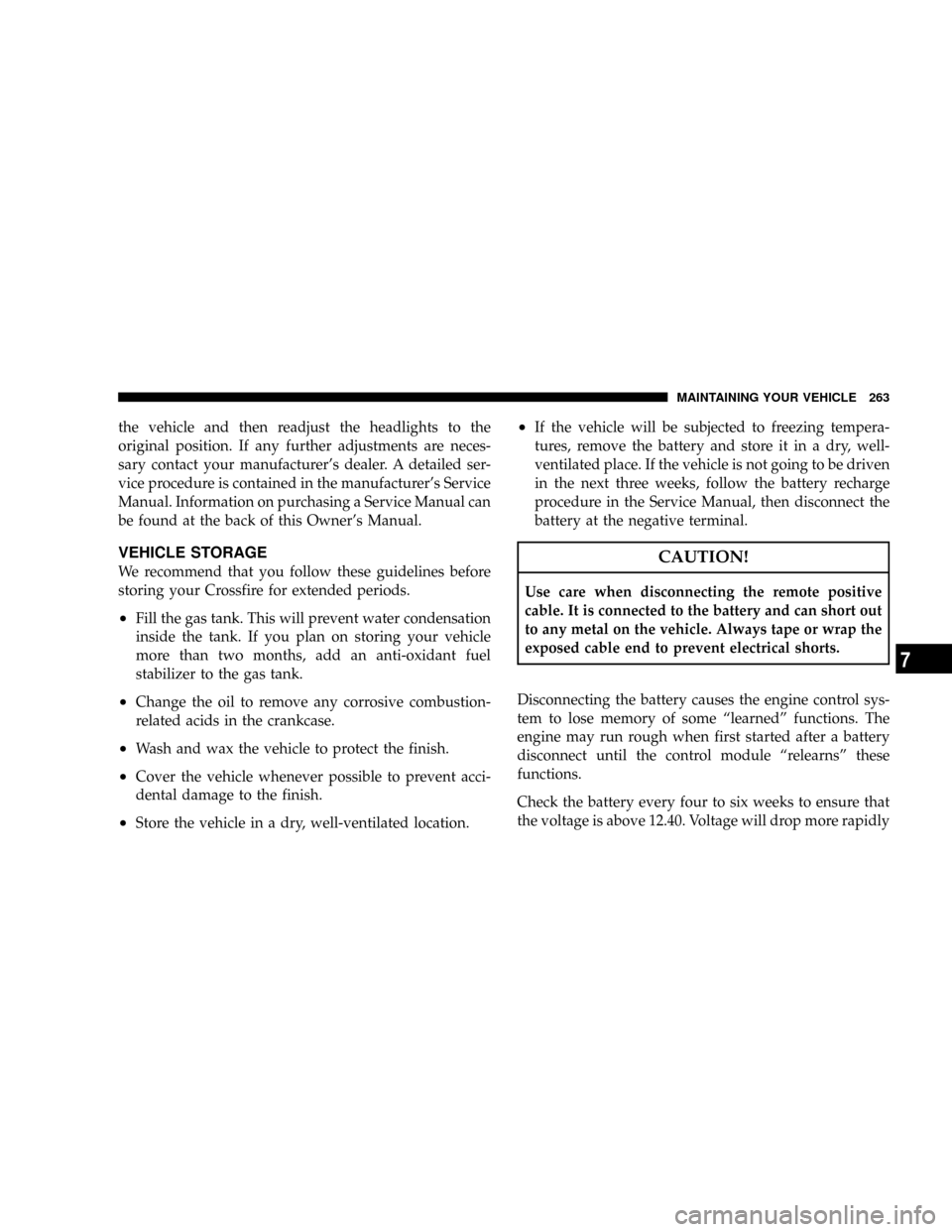
the vehicle and then readjust the headlights to the
original position. If any further adjustments are neces-
sary contact your manufacturer's dealer. A detailed ser-
vice procedure is contained in the manufacturer's Service
Manual. Information on purchasing a Service Manual can
be found at the back of this Owner's Manual.
VEHICLE STORAGE
We recommend that you follow these guidelines before
storing your Crossfire for extended periods.
²Fill the gas tank. This will prevent water condensation
inside the tank. If you plan on storing your vehicle
more than two months, add an anti-oxidant fuel
stabilizer to the gas tank.
²Change the oil to remove any corrosive combustion-
related acids in the crankcase.
²Wash and wax the vehicle to protect the finish.
²Cover the vehicle whenever possible to prevent acci-
dental damage to the finish.
²Store the vehicle in a dry, well-ventilated location.
²If the vehicle will be subjected to freezing tempera-
tures, remove the battery and store it in a dry, well-
ventilated place. If the vehicle is not going to be driven
in the next three weeks, follow the battery recharge
procedure in the Service Manual, then disconnect the
battery at the negative terminal.
CAUTION!
Use care when disconnecting the remote positive
cable. It is connected to the battery and can short out
to any metal on the vehicle. Always tape or wrap the
exposed cable end to prevent electrical shorts.
Disconnecting the battery causes the engine control sys-
tem to lose memory of some ªlearnedº functions. The
engine may run rough when first started after a battery
disconnect until the control module ªrelearnsº these
functions.
Check the battery every four to six weeks to ensure that
the voltage is above 12.40. Voltage will drop more rapidly
MAINTAINING YOUR VEHICLE 263
7
Page 267 of 299
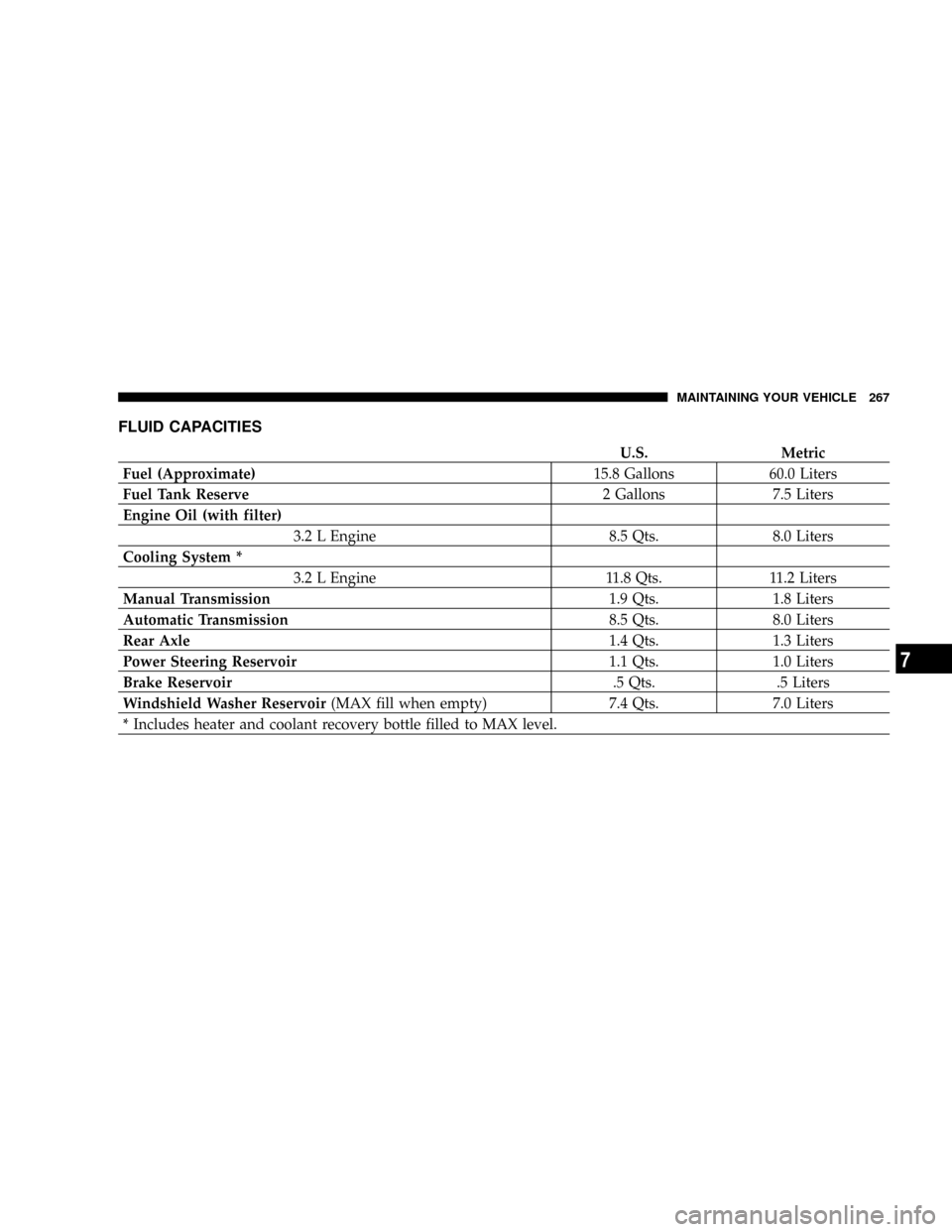
FLUID CAPACITIES
U.S. Metric
Fuel (Approximate)15.8 Gallons 60.0 Liters
Fuel Tank Reserve2 Gallons 7.5 Liters
Engine Oil (with filter)
3.2 L Engine 8.5 Qts. 8.0 Liters
Cooling System *
3.2 L Engine 11.8 Qts. 11.2 Liters
Manual Transmission1.9 Qts. 1.8 Liters
Automatic Transmission8.5 Qts. 8.0 Liters
Rear Axle1.4 Qts. 1.3 Liters
Power Steering Reservoir1.1 Qts. 1.0 Liters
Brake Reservoir.5 Qts. .5 Liters
Windshield Washer Reservoir(MAX fill when empty) 7.4 Qts. 7.0 Liters
* Includes heater and coolant recovery bottle filled to MAX level.
MAINTAINING YOUR VEHICLE 267
7
Page 268 of 299
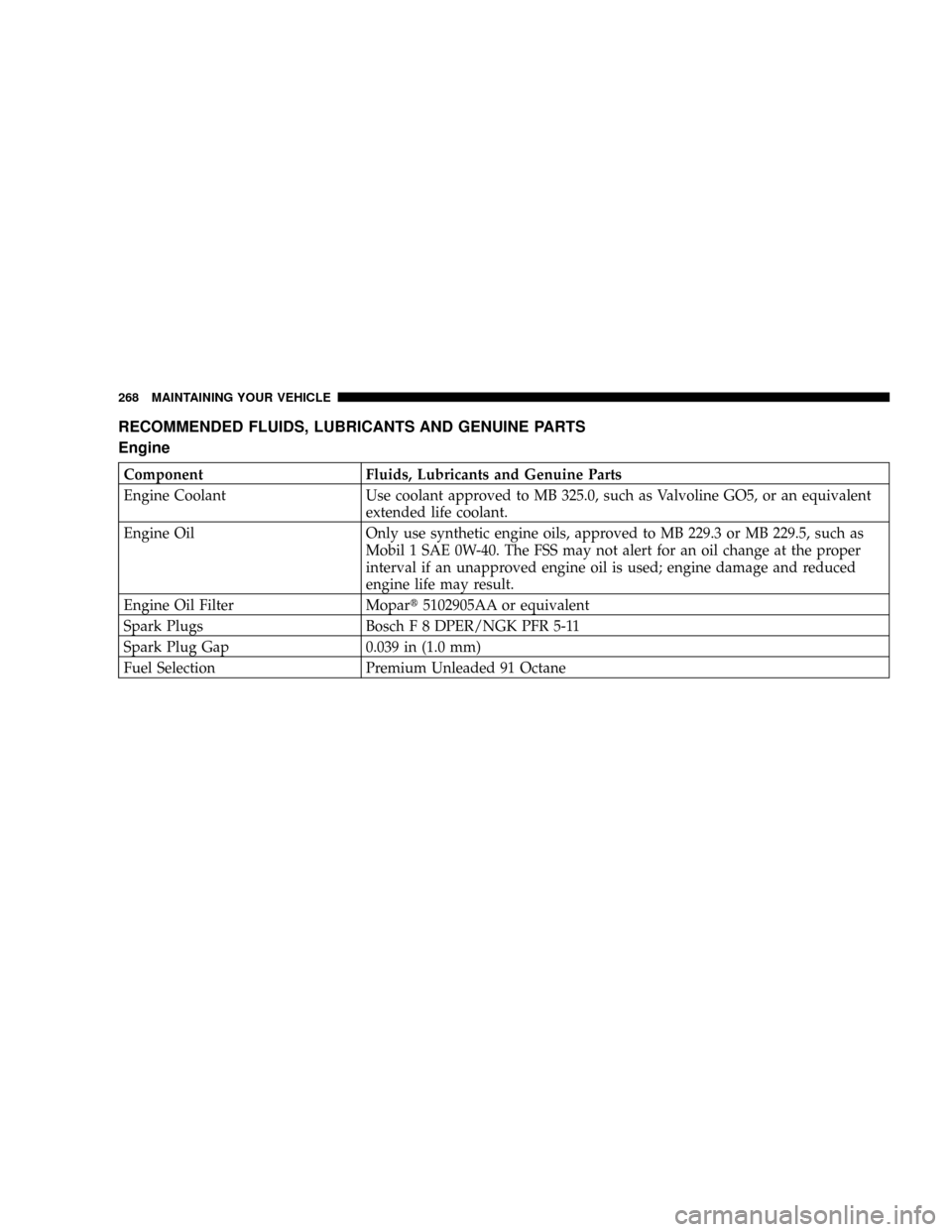
RECOMMENDED FLUIDS, LUBRICANTS AND GENUINE PARTS
Engine
Component Fluids, Lubricants and Genuine Parts
Engine Coolant Use coolant approved to MB 325.0, such as Valvoline GO5, or an equivalent
extended life coolant.
Engine Oil Only use synthetic engine oils, approved to MB 229.3 or MB 229.5, such as
Mobil 1 SAE 0W-40. The FSS may not alert for an oil change at the proper
interval if an unapproved engine oil is used; engine damage and reduced
engine life may result.
Engine Oil Filter Mopart5102905AA or equivalent
Spark Plugs Bosch F 8 DPER/NGK PFR 5-11
Spark Plug Gap 0.039 in (1.0 mm)
Fuel Selection Premium Unleaded 91 Octane
268 MAINTAINING YOUR VEHICLE
Page 278 of 299
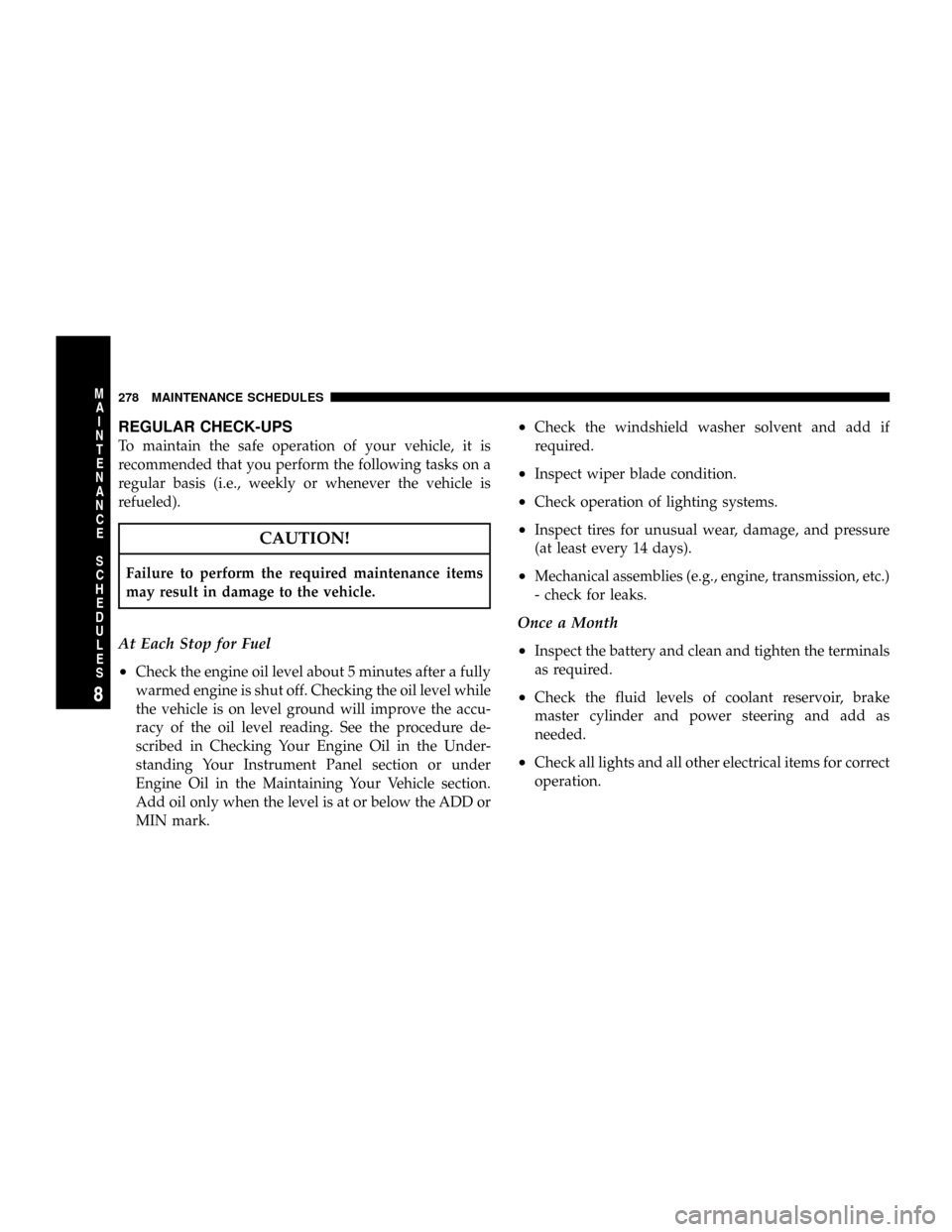
REGULAR CHECK-UPS
To maintain the safe operation of your vehicle, it is
recommended that you perform the following tasks on a
regular basis (i.e., weekly or whenever the vehicle is
refueled).
CAUTION!
Failure to perform the required maintenance items
may result in damage to the vehicle.
At Each Stop for Fuel
²
Check the engine oil level about 5 minutes after a fully
warmed engine is shut off. Checking the oil level while
the vehicle is on level ground will improve the accu-
racy of the oil level reading. See the procedure de-
scribed in Checking Your Engine Oil in the Under-
standing Your Instrument Panel section or under
Engine Oil in the Maintaining Your Vehicle section.
Add oil only when the level is at or below the ADD or
MIN mark.
²Check the windshield washer solvent and add if
required.
²Inspect wiper blade condition.
²Check operation of lighting systems.
²Inspect tires for unusual wear, damage, and pressure
(at least every 14 days).
²Mechanical assemblies (e.g., engine, transmission, etc.)
- check for leaks.
Once a Month
²
Inspect the battery and clean and tighten the terminals
as required.
²Check the fluid levels of coolant reservoir, brake
master cylinder and power steering and add as
needed.
²Check all lights and all other electrical items for correct
operation.
278 MAINTENANCE SCHEDULES
8
M
A
I
N
T
E
N
A
N
C
E
S
C
H
E
D
U
L
E
S
Page 279 of 299
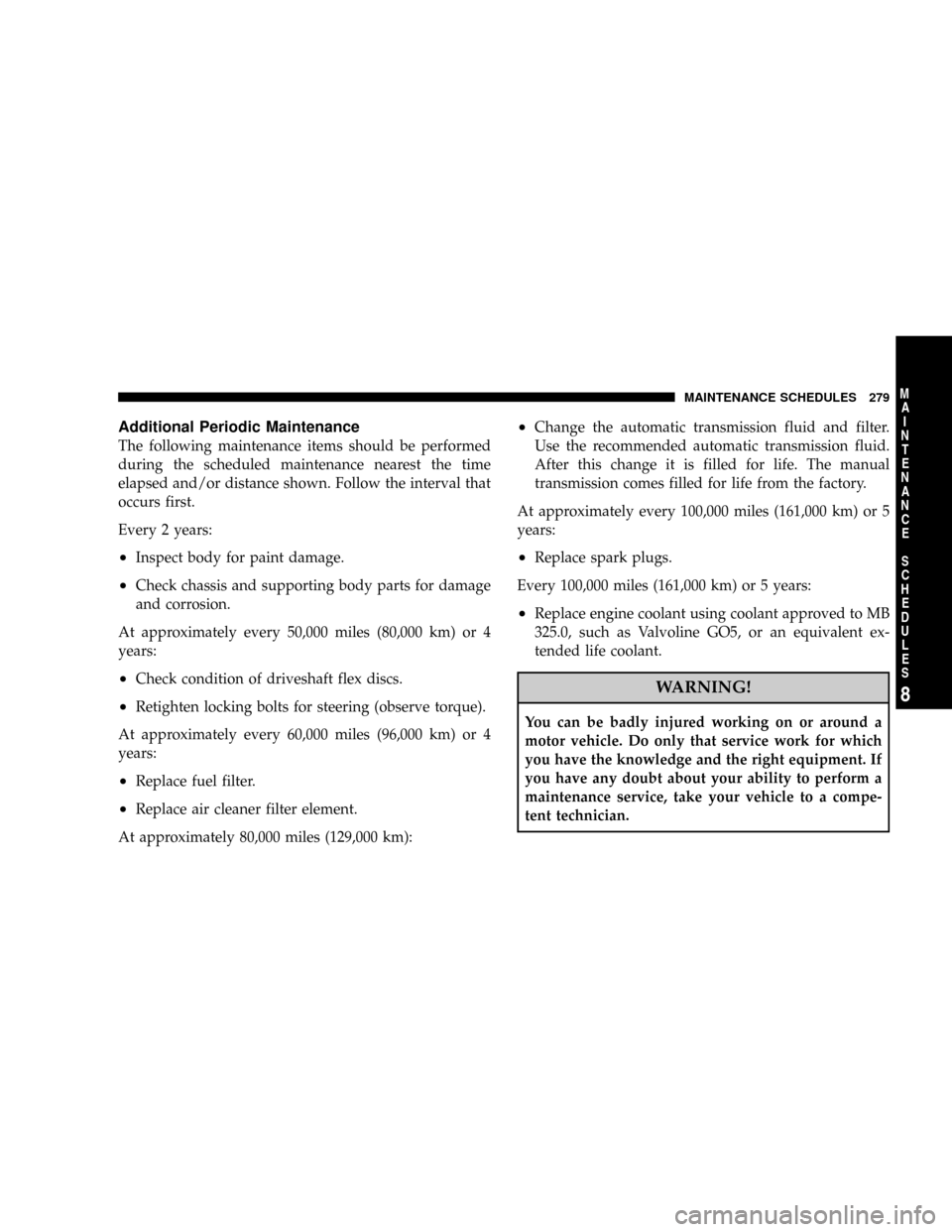
Additional Periodic Maintenance
The following maintenance items should be performed
during the scheduled maintenance nearest the time
elapsed and/or distance shown. Follow the interval that
occurs first.
Every 2 years:
²Inspect body for paint damage.
²Check chassis and supporting body parts for damage
and corrosion.
At approximately every 50,000 miles (80,000 km) or 4
years:
²Check condition of driveshaft flex discs.
²Retighten locking bolts for steering (observe torque).
At approximately every 60,000 miles (96,000 km) or 4
years:
²Replace fuel filter.
²Replace air cleaner filter element.
At approximately 80,000 miles (129,000 km):
²Change the automatic transmission fluid and filter.
Use the recommended automatic transmission fluid.
After this change it is filled for life. The manual
transmission comes filled for life from the factory.
At approximately every 100,000 miles (161,000 km) or 5
years:
²Replace spark plugs.
Every 100,000 miles (161,000 km) or 5 years:
²Replace engine coolant using coolant approved to MB
325.0, such as Valvoline GO5, or an equivalent ex-
tended life coolant.
WARNING!
You can be badly injured working on or around a
motor vehicle. Do only that service work for which
you have the knowledge and the right equipment. If
you have any doubt about your ability to perform a
maintenance service, take your vehicle to a compe-
tent technician.
MAINTENANCE SCHEDULES 279
8
M
A
I
N
T
E
N
A
N
C
E
S
C
H
E
D
U
L
E
S
Page 290 of 299

ABS (Anti-Lock Brake System)............. 118
Adding Engine Coolant (Antifreeze)......... 239
Adding Fuel.......................... 189
Aiming Headlights...................... 262
Air Cleaner, Engine
(Engine Air Cleaner Filter)................ 229
Air Conditioning....................135,232
Air Conditioning Filter................... 280
Air Conditioning Refrigerant.............. 233
Air Conditioning System................. 232
Air Pressure, Tires...................... 176
Airbag................................ 30
Airbag Deployment...................... 36
Airbag Light........................35,123
Airbag Maintenance...................... 46
Airbag On/Off Switch..................43,48
Alignment and Balance.................. 181
Antenna.............................. 134
Antifreeze (Engine Coolant)............... 267
Anti-Lock Warning Light................. 118
Appearance Care....................... 246
Ashtrays and Lighter..................... 74
Automatic Door Locks.................... 13Automatic Transmission...............149,244
Fluid and Filter Changes................ 245
Fluid Level Check..................... 245
Fluid Type.......................... 244
Special Additives..................... 246
Autostick............................. 152
Ball Joints............................ 234
Battery............................ 119,231
Saving Feature (Protection)............... 85
Belts, Drive........................... 229
Belts, Seat............................. 23
Body Mechanism Lubrication.............. 235
Brake Assist System...................... 98
Brake, Parking......................... 156
Brake System.......................157,242
Anti-Lock (ABS)...................... 157
Hoses.............................. 242
Master Cylinder...................... 243
Break-In Recommendations, New Vehicle . . . 55,166
Bulbs, Light........................... 259
Capacities, Fluid....................... 265
290 INDEX
Page 292 of 299

Defroster, Windshield..................... 56
Disposal
Engine Oil.......................... 228
Door Locks, Automatic................... 13
Drive Belts............................ 229
Drive Shaft Universal Joints............... 234
Driving
On Slippery Surfaces.................. 205
Electronic Speed Control (Cruise Control)..... 102
Electronic Stability Program (ESP)........... 99
Emergency, In Case of
Hazard Warning Flasher................ 194
Jump Starting........................ 203
Overheating......................... 194
Towing............................. 206
Emergency Trunk Release................. 20
Emission Control System Maintenance....223,273
Engine
Break-In Recommendations............... 55
Checking Oil Level.................... 225
Compartment........................ 221
Oil .............................225,267Oil Change Interval................... 227
Oil Selection......................... 228
Exhaust Gas Caution..................... 55
Exhaust System........................ 237
Exterior Lights......................... 259
Filters
Air Cleaner.......................... 229
Air Conditioning..................... 280
Engine Fuel......................... 229
Engine Oil.......................... 228
Fluid Capacities.....................265,267
Fluid Leaks............................ 57
Fluid Level Checks
Manual Transmission.................. 245
Fluids, Lubricants and Genuine Parts........ 268
Four-Way Hazard Flasher................. 194
Freeing A Stuck Vehicle.................. 206
Fuel................................. 186
Adding............................. 189
Additives........................... 188
Filler Cap (Gas Cap)................... 189
Filter.............................. 229
292 INDEX
Page 293 of 299

Octane Rating........................ 186
Fuses................................ 253
Garage Door Opener (HomeLinkt) .......... 105
Gas Cap (Fuel Filler Cap)................. 189
Gasoline (Fuel)......................... 267
Gasoline/Oxygenate Blends............... 187
Gear Ratios........................... 265
General Information..................... 183
Glass Cleaning......................... 250
Glove Compartment..................... 76
Hazard Warning Flasher.................. 194
Headlights
Aiming............................. 262
Cleaning............................ 249
Dimmer Switch....................... 89
Heater............................... 135
Hood Latch Maintenance................. 235
Hood Release.......................... 84
Hoses............................... 241Ignition
Key ................................. 9
Wiring System (Spark Plug Wires)......... 231
Illuminated Entry....................... 86
Infant Restraint......................... 48
Inside Rearview Mirror................... 77
Instrument Cluster...................... 113
Instrument Panel and Controls............. 112
Instrument Panel Cover.................. 250
Instrument Panel Lens Cleaning............ 250
Interior Appearance Care................. 249
Introduction............................ 4
Jack Location.......................... 200
Jack Operation......................... 195
Jump Starting......................... 203
Key-In Reminder........................ 10
Keyless Entry System..................... 14
Keys.................................. 9
Knee Bolster........................... 30
INDEX 293
10